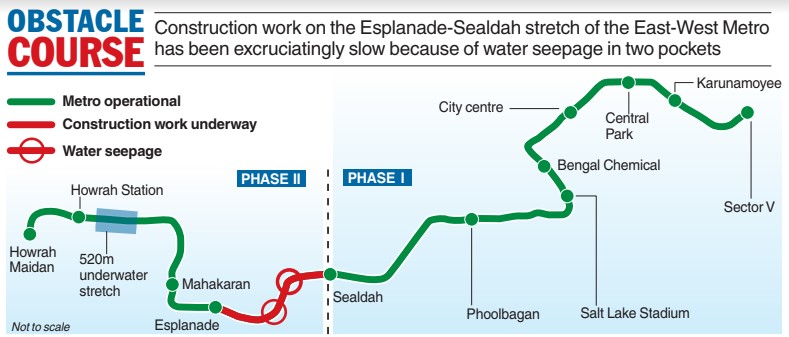The East-West Metro construction work between Esplanade and Sealdah — the last unfinished stretch of the corridor — has been excruciatingly slow because water has continued to seep into certain portions, said engineers and officials involved in the project.
Hundreds of tonnes of grouting material are being injected into the ground to build an evacuation shaft and a cross-passage between two tunnels. Work is also
on to close a cross-passage that had to be abandoned halfway into the
construction.
However, despite the grouting, water has continued to seep, said engineers of the Kolkata Metro Rail Corporation (KMRC), the implementing agency for the project.
The builders are working very slowly on the unfinished 2.5km section of the 16.6km Green Line. This is the stretch that has already witnessed three incidents of subsidence between 2019 and 2022.
The tunnel boring machine burrowing the east-bound (Sealdah-bound) tunnel hit a sand aquifer on August 31, 2019, leading to the first major subsidence.
Families living in nearly 70 houses had to be evacuated as they developed cracks. Of these, more than 25 had to be demolished because of the extent of damage. Hundreds of people are still staying elsewhere in rented accommodation.
Experts said sand aquifers are common under Calcutta’s surface and are usually found 20m underground. Intense grouting and caution are the two ways to deal with the problem.
On May 11, 2022, the construction of a shaft led to a water leak again, causing further damage to several buildings around Bowbazar.

On October 14 the same year, the third incident of water seepage happened during the construction of a cross-passage to link the two tunnels.
Engineers described the evacuation shaft at Bowbazar as “the main and most challenging work”.
The other problem areas are cross-passage 5B, which is being constructed around 800m from Esplanade towards Sealdah, and closing down cross-passage 2 with concrete, around 400m from Sealdah towards Esplanade.
“Water is trickling in intermittently. The water table is at a depth of 2m to 2.5m from the surface. We are working at a level 25m deep and so water is all around us,” said a senior KMRC official.
East-West Metro is now operational on two fragmented stretches, between Howrah Maidan and Esplanade including a 520m stretch under the Hooghly, and the second between Sealdah and Sector V. The Howrah Maidan-Esplanade stretch became commercially operational on March 15.
”Water seeps in every now and then. We are now doing extensive grouting to stop water ingress. When it is completely safe, we will cut through the soil before putting the concrete,” said the KMRC official.
Several engineers said they were wary after the earlier subsidence and wanted to go slow. ”We don’t want to take any chance. If there is another subsidence, the future of the stretch will become uncertain,” said one engineer.
The location of cross-passage 5B was shifted to make the construction safer. However, water continues to seep in. The passage is now under the road near Hind Inox on GC Avenue.
”Work on the evacuation shaft has been slow. Work on the cross-passages is on course. The location of cross-passage (5B) was shifted 100m because the nature of the soil is better at the new location. We are taking all the precautions needed. The situation is fully under control,” said V.K. Srivastava, managing director of the KMRC.
The under-construction cross-passage near Madan Dutta Lane, which was part of the original plan, is being sealed now. The original plan was to have eight cross-passages. This was later changed to five.
The three incidents of soil subsidence caused some “minor damage” to the underground tunnels, said engineers. “The tunnels are still safe. We have built them to last 120 years. As an additional layer of safety, steel liners are being installed inside the tunnels,” said a KMRC official.
John Endicott, a specialist in the design and construction of underground structures who was in Bowbazar after the subsidence in 2019 to find a way to deal with the water, said: “As a principle, when digging a cross-passage, it is necessary to keep groundwater out. Grouting the soil with impermeable material is a standard practice to stiffen the soil and lower its permeability. Other methods include freezing the ground around the cross-passages; this is effective even in hot countries.”
Engineers in Calcutta said they were using epoxy grout to stop the flow of water.
KMRC officials have set an internal target of May 15 to complete the civil engineering work in the Esplanade-Sealdah section, said sources in the agency.
“Broadly, we are looking at May-end to complete civil engineering work. After that, electrical and signalling work will start. That takes up a lot of time. But if we stick to the May target, the section should be commissioned by October this year,” the official said.
The east-bound (Sealdah-bound) tunnel has a full course of tracks. The west-bound (Esplanade-bound) tunnel has more than 1.5km that do not yet have railway tracks, said an official.






